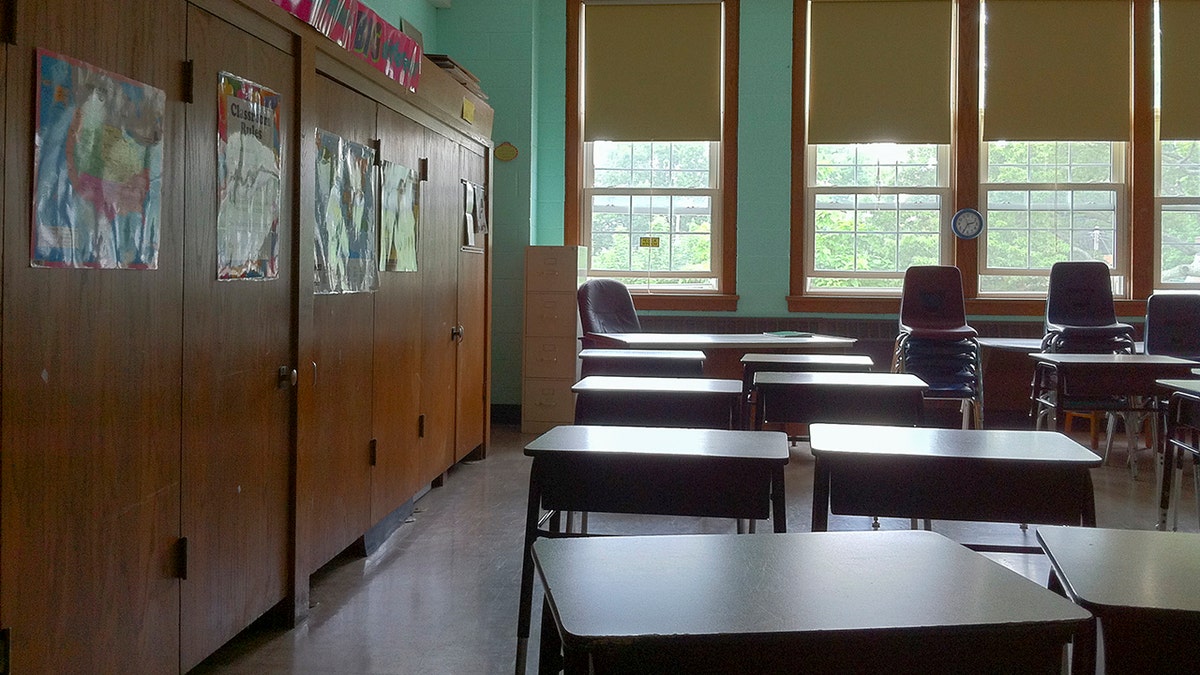In a series of federal bailouts since the onset of COVID-19 in March 2020, public schools have received $190 billion extra to spend. Despite this windfall, a lot remains unspent, and states and even some public school districts have been accumulating record rainy day funds.
Now, the Biden administration is urging public schools to "be considering" permanent funding commitments with their temporary bailout billions that need to be spent by September 2024. Although some districts have staff shortages, giving this advice to all school districts is, quite simply, irresponsible.
BIDEN SAYS STUDENTS ARE LIKE TEACHERS' CHILDREN WHEN IN CLASSROOM

Empty Classroom In Elementary School. (Education Images/Universal Images Group via Getty Images)
History shows that districts should be extremely careful with hiring more staff with temporary federal funds—districts without real shortages should avoid this completely even knowing that the amount of the extra federal taxpayer funds has been ludicrously large. If they do, they run the risk of having to raise property taxes when the temporary funds run out.
Instead, districts should use their considerable influx in resources to address the real pandemic-related education challenge: learning losses that students are facing due to school shutdowns and COVID-19 stresses.
Decades of evidence is inconclusive on whether public schools’ expensive remediation efforts generally benefit students on a large scale. States and districts should give parents more opportunities to get involved.
The fastest and best way to do this is for states and districts to directly fund families and get them more involved in the education of their children. Providing modest accounts for parents would empower them to find the best remediation and tutoring services for their children. These remediation accounts could have a name like "Child Opportunity Grants," and parents could use these grants to access tutoring services, online courses, and other educational services.
This is already happening in some forward-thinking communities, where districts are funding families to access educational services outside of their assigned schools to help make up for learning loss. Districts in states such as California, Pennsylvania, South Dakota, and Tennessee have already done this with efforts like paying parents to transport their own kids to school, and providing money to families to buy their own school supplies.
Other sensible alternatives for districts include spending federal funds on repairing buildings and other capital needs—which, as a bonus, will save money in the future—and one-time signing and retention bonuses where they are short-staffed, matching perks seen in other industries needing to attract and retain staff.
What school districts generally do not need is to hire extra permanent staff to last beyond this cash infusion. Washington is telling districts to do this despite public school enrollments dropping and the feds projecting their enrollment to drop further.
Districts already have been hiring more staff for decades. Since 1950, increases in the number of public school employees have far outpaced increases in their student populations. For example, since 1950 the number of public school students in America has roughly increased by 100 percent, but the number of school personnel has increased almost 400 percent.
CLICK HERE TO GET THE OPINION NEWSLETTER
Now people are worried about a looming fiscal cliff in September 2024 when federal bailout funds run dry and public school staff layoffs may occur. The last time school staffing saw a downturn occurred between fall 2009 and fall 2011, during the Great Recession, when 3.3 percent of public school staff positions were eliminated despite schools receiving federal stimulus funding. But, starting the next year, staffing resumed its upward trend again, continuing a pattern that revealed an over 250% increase in staff in decades prior.
Decades of history suggest those concerned about layoffs in 2024 need not worry. All eight states that experienced student enrollment declines between 1992 and 2015 increased the number of public school staff they employ!
CLICK HERE TO GET THE FOX NEWS APP
State policymakers and district leaders do not need to continue down the path of the public school staffing surge and its decades of stagnant outcomes for students—especially with student enrollments projected to drop and the feds giving them bad advice on how to spend their bailout billions. Instead, they should pursue thoughtful policies to help get students back on track after the tumult of the past two years.
Marty Lueken is the director of the Fiscal Research and Education Center at EdChoice.
























